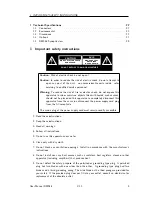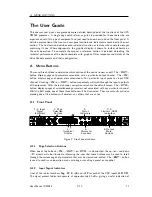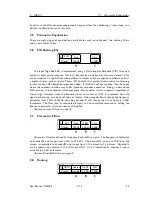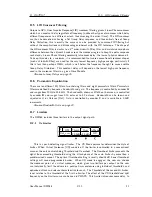
C
INPUT
C.5
Parametric Equalisation
its order as the filter becomes progressively steeper rather than following a linear slope so a
dB/octave description is not accurate.
C.5
Parametric Equalisation
There are eight stages of equalisations available for each input channel, two shelving filters
and six parametric filters.
C.6
FIR Shelving EQ
A
FIR/
Preset
1
Freq
100Hz
Gain
0.0dB
The Input High Shelf EQ is implemented using a Finite Impulse Response (FIR) filter, and
exhibits a linear phase response; that is all frequencies are delayed by the same amount. This
can be important in applications where different amounts of EQ are applied to different parts of
a speaker cluster, such as to add ’Throw’ EQ boost so that parts of cluster which are throwing
further can have HF absorption correction added. If this EQ is not linear phase, then the zones
where the speakers combine may suffer frequency response anomalies. Being a linear phase
FIR equaliser, this necessarily introduces some latency delay, which is constant regardless of
the settings. However, when the frequency is set to maximum (Off), it is removed from the
signal path entirely, so it does not add any latency. Using encoder
A
will change the frequency
parameter from 2kHz to 20kHz and using encoder
C
will change the cut or boost in 0.2dB
increments. The filter (and its associated latency) can be completely removed by setting the
frequency parameter to the maximum off position.
Also see Latency Delays on page 25.
C.7
Parametric Filters
A
EQ1
Preset
1
Freq
100Hz
Width
1.0oct
Gain
0.0dB
Parametric filters are defined by frequency, bandwidth and gain. The frequency is controlled
by encoder
A
and ranges from 10Hz to 25.6kHz. The bandwidth, shown as Width on the
screen, is controlled by encoder
B
and ranges from 0.10 octaves to 5.2 octaves. Bandwidth
can be shown and adjusted as Q or Octaves (Oct). Gain is controlled by encoder C and is
available in 0.2dB increments.
Also see Bandwidth Units on page 23.
C.8
Routing
A ROUT
Preset
1
Source
Analog
AES3
0.0dB
Net
0.0dB
User Manual DMS48
V1.1
19
Summary of Contents for DMS48
Page 1: ...User Manual Digital Processor DMS48...
Page 2: ......
Page 29: ......
Page 30: ......
Page 31: ......














































